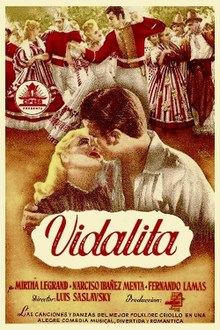Vidalita
| Vidalita | |
|---|---|
 Spanish theatrical release poster | |
| Directed by | Luis Saslavsky |
| Written by | Ariel Cortazzo Luis Saslavsky |
| Story by | Luis Saslavsky |
| Starring | Mirtha Legrand Fernando Lamas Narciso Ibáñez Menta |
| Cinematography | Pablo Tabernero |
| Edited by | Gerardo Rinaldi |
| Music by | Juan Ehlert Luis Gianneo Alejandro Gutiérrez del Barrio Sebastián Piana |
Production company | |
Release date |
|
Running time | 95 minutes |
| Country | Argentina |
| Language | Spanish |
Vidalita is a 1949 Argentine comedy film directed and co-written by Luis Saslavsky and produced by Emelco during the classical era of Argentina cinema. It stars Mirtha Legrand as the title character, a girl who cross-dresses as a gaucho to be able to take charge of her grandfather's estate. This was considered transgressive for the time.i[1] Fernando Lamas stars as the captain of the fort, who falls in love with Legrand's character "to the point that he is willing to marry her without knowing if she is a man or a woman".[1]
Cast
[edit]- Mirtha Legrand
- Narciso Ibáñez Menta
- Fernando Lamas
- Amalia Sánchez Ariño
- Oscar Valicelli
- Milagros de la Vega
- Leticia Scury
Reception
[edit]The film was poorly received by the media related to Peronism.[2] According to Saslavsky, they "find that a gaucho represented by a girl in disguise is a lack of machismo, of criollismo."[3] Writing for Página/12's LGBT periodical Soy in 2022, Adrián Melo stated:
In a key scene, Vidalita-Legrand finds herself in the situation of sharing a room where Lamas bathes naked and in another she dances with him in front of a people who are shocked to see two passionate men together. Only for this 1949 film directed by Luis Saslavsky, Legrand would deserve to enter the eternal sky with stars of the LGTBIQ world.
There is probably nothing in Argentine cinematography—neither before nor after—so deliciously erotic and transgressive in relation to sexual dissidence, nor so subversive in dealing with two founding topics of nationality and local hegemonic masculinity: being a gaucho and being a soldier.[1]
Raúl Manrupe and María Alejandra Portela described it as a "mythical work and an accursed classic."[2] In 2022, it ranked 51st in the list of The 100 Greatest Films of Argentine Cinema, a poll organized by the specialized magazines La vida útil, Taipei and La tierra quema, which was presented at the Mar del Plata International Film Festival.[4]
See also
[edit]References
[edit]- ^ a b c Melo, Adrián (24 February 2022). "Mirtha Legrand cumple 95 años: ¿Lo digo o no lo digo?". Soy. Página/12 (in Spanish). Retrieved 24 November 2022.
- ^ a b Manrupe, Raúl; Portela, María Alejandra (2001). Un diccionario de films argentinos (1930-1995) (in Spanish). Buenos Aires: Editorial Corregidor. p. 392. ISBN 950-05-0896-6.
- ^ Barney Finn, Oscar (1994). Los directores del cine argentino. Luis Saslavsky (in Spanish). Buenos Aires: Centro Editor de América Latina. p. 15. ISBN 950-25-3174-4.
- ^ "Top 100" (in Spanish). Encuesta de cine argentino 2022. 11 November 2022. Retrieved 13 November 2022.
